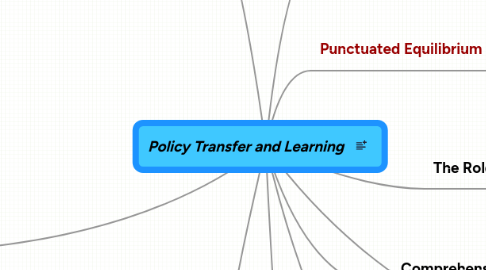Policy Transfer and Learning
by Paul Cairney


1. Policy Change
1.1. Transfer is an important source of policy change
1.2. Or the transfer process can be used to legitimise exisitng policy
2. Key Points
2.1. • Refers to the evidence for - and causes of - similarities in policy across regions
2.2. • The actors involved are a combination of usual suspects (elected officials, parties, civil service, etc.) as well as “policy entrepreneurs” and supra-national organisations.
2.3. • The nature of transfer can be seen on a continuum, from voluntary to coercive. This includes indirect coercion which may suggest a perceived need to transfer, often without exerted influence
2.4. • A variety of policy-related factors may be transferred – from ideologies and wholesale programmes to administrative arrangements or just broad ideas. Negative lessons may also be learned
2.5. • The level of transfer ranges from complete duplication to broad inspiration.
2.6. • Policy conditions, geography and ideology affect the willingness to study other regions.
2.7. • Transfer is most likely if the policy is simple, the values of borrower and lender coincide and the political structures/ administrative arrangements are similar.
2.8. We can link the study of transfer to a range of related concepts (on the right).
2.8.1. Click on the link for punctuated equilibrium to see its own mindmap.
3. Common Terms
3.1. Lesson Drawing
3.1.1. Richard Rose
3.1.2. Lessons sought from other countries after policy failure
3.1.3. Technical focus
3.1.3.1. How do we do it?
3.1.3.2. Which countries are most likely sources?
3.1.3.3. Degrees of Transfer
3.1.3.3.1. Complete duplilcation
3.1.3.3.2. Adaptation
3.1.3.3.3. Hybrid
3.1.3.3.4. Synthesis
3.1.3.3.5. Broad Inspiration
3.2. Policy Convergence
3.3. Policy Transfer
3.4. Policy Diffusion
3.4.1. Jack Walker
3.4.2. Focus on US
3.4.3. Key question: why do some states innovate and others emulate?
